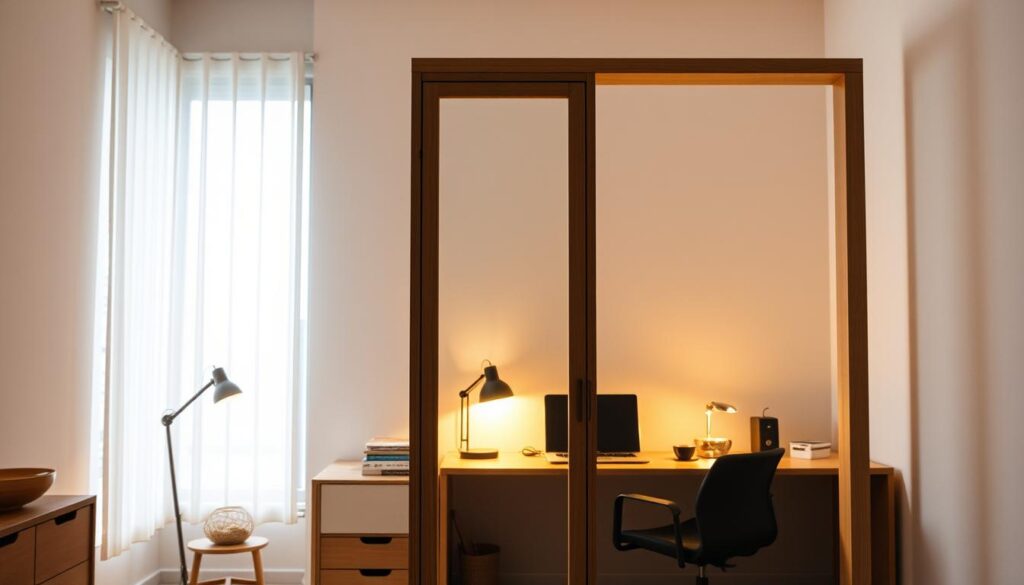Budget-friendly room dividers every student needs for privacy
Discover the best budget-friendly room dividers for students seeking privacy. Explore our roundup of affordable options now.
Living in shared dorms or compact apartments often leaves students scrambling to carve out private areas. Between study sessions, relaxation time, and social activities, personal space becomes a rare commodity. Traditional remodeling isn’t an option, but creative alternatives exist.

Versatile partition screens solve this problem without draining wallets. These adaptable pieces range from lightweight folding panels to bookcase-style units that double as storage. Many options cost less than a week’s groceries, fitting easily into tight budgets.
Modern designs blend function with style, offering choices from minimalist fabric screens to geometric wooden frames. Students can match their divider to existing decor while maximizing small living areas. The best models fold flat for easy moves between apartments or campus housing.
Strategic placement creates instant study nooks or sleeping quarters in open layouts. This simple upgrade helps reduce stress and improve focus – crucial benefits during exams. Temporary setups also respect rental agreements that prohibit permanent changes.
Key Takeaways
- Compact living spaces challenge students’ need for dedicated work and relaxation areas
- Multi-purpose partitions create separate zones without construction or high costs
- Lightweight materials and collapsible designs suit frequent moves between residences
- Stylish options complement existing decor while serving practical needs
- Proper space division enhances concentration and overall well-being
- Most effective solutions cost under $100 and require no installation
Introduction: Creating Private Spaces on a Budget
Finding solitude in student housing can feel like solving a spatial puzzle. Shared living areas often force roommates to coexist in overlapping zones for studying, sleeping, and socializing. Strategic solutions help define boundaries without permanent changes or breaking the bank.
Why Students Need Smart Space Management
Visual separation transforms chaotic environments into organized spaces. A well-placed partition reduces distractions during late-night study sessions while maintaining airflow and natural light. These temporary barriers also help preserve relationships by giving everyone breathing room.
What Else Would You Like to Know?
Choose below:
What This Guide Delivers
Discover practical approaches to personalize compact home setups. Learn how foldable screens and modular units create instant workstations or sleeping nooks. The article breaks down measurement tips, material comparisons, and placement strategies that respect rental agreements.
Real student experiences showcase how simple adjustments improve focus and reduce stress. Expect actionable advice for balancing privacy needs with style preferences – all while keeping costs lower than a semester textbook.
Recognizing the Need for Room Dividers in Student Living
Modern student housing often forces multiple functions into tight quarters. Shared apartments and dorms merge sleeping, studying, and socializing into single areas, leaving little separation between activities. This setup creates daily challenges for those needing focused workspaces or quiet zones.
Open-concept layouts intensify these struggles. A typical studio combines the living room, bedroom, and study area into one undivided space. Students report difficulty maintaining routines when their bed sits three feet from their desk.
Conflicting schedules between roommates add another layer. Night owls and early risers coexist in overlapping zones, creating tension. Visual barriers help manage noise and activity levels without awkward confrontations.
Virtual obligations further complicate shared spaces. Over 60% of students cite unprofessional backgrounds during video calls as a stressor. Temporary partitions create instant “offices” that maintain academic credibility.
- Establishes psychological boundaries in temporary housing
- Reduces distractions during exams or important deadlines
- Preserves relationships through respectful space management
With most learners moving annually, permanent solutions aren’t practical. Lightweight alternatives adapt to different rooms and layouts while respecting rental rules. These flexible tools bridge the gap between communal living and personal needs.
Understanding Key Features in Affordable Room Dividers
Selecting the right partition requires balancing practical needs with personal taste. Smart shoppers prioritize materials that withstand daily use while complementing their existing setup. This section breaks down critical factors influencing performance and visual harmony.

Materials, Build Quality, and Durability
Wood frames lead in longevity, resisting dents better than plastic alternatives. Metal joints and reinforced corners prevent wobbling in high-traffic areas. Fabric panels absorb sound effectively but require regular cleaning.
Consider these material comparisons:
| Type | Durability | Maintenance |
|---|---|---|
| Solid Wood | 10+ years | Occasional polishing |
| Powder-Coated Metal | 5-7 years | Wipe downs |
| Polyester Fabric | 2-3 years | Machine wash |
Style, Color, and Design Options
Neutral colors like slate gray adapt to changing decor schemes. Geometric patterns add personality without overwhelming small spaces. Frosted acrylic panels maintain light flow while obscuring clutter.
Open-frame designs create separation without closed-off feelings. Rotating panels let users adjust privacy levels throughout the day. Some units incorporate magnetic surfaces for displaying notes or artwork.
Exploring Affordable Folding Screens for Small Spaces
College life demands adaptable solutions for ever-changing living situations. Folding screens emerge as practical tools that balance privacy needs with spatial limitations. These collapsible units transform shared environments without permanent alterations, making them ideal for temporary housing setups.
Functionality and Portability
The Vivo 3-Panel design demonstrates how affordability meets practicality. Priced between $45-$65, its MDF frame and fabric panels withstand daily use while blending into most decors. Available in neutral tones, it adapts to dorm aesthetics without dominating the space.
For broader coverage, the Blissun 4-Panel model adds an extra section at $70-$90. Its wooden frame provides stability in open layouts, while fabric surfaces dampen sound during study sessions. Both options collapse to suitcase size, perfect for storage under beds or in closets.
Students appreciate how these folding screens serve multiple roles. They create professional video call backgrounds and display areas for motivational posters. Strategic placement near windows forms sunlit study corners, while angled configurations hide laundry piles during unexpected guest visits.
Lightweight construction remains crucial for frequent movers. Most models weigh less than 15 pounds, allowing easy transport between housing setups. This mobility ensures students invest in solutions that last through multiple academic years without clutter.
Innovative and Multi-functional Divider Designs
Creative space solutions now blend practical separation with smart functionality. Modern designs transform basic barriers into organizational powerhouses, addressing multiple needs in compact living environments.
DIY Enhancements and Built-in Features
Bookcase-style units lead the way in dual-purpose innovation. Resource Furniture’s fold-down desk model demonstrates how vertical storage can create instant workspaces. These floor-to-ceiling shelves maintain visual openness while hiding clutter behind textbooks or decorative items.
Suspended systems offer space-saving alternatives for renters. Designer Rodney Lawrence used ceiling-mounted shelves to carve distinct zones without permanent installations. This approach keeps floors clear for movement while adding display areas for plants or lighting.
Students enhance basic panels through:
- Clip-on LED strips for task lighting
- Fabric sleeves holding school supplies
- Magnetic surfaces for schedules and reminders
The best divider offers hidden perks like built-in charging stations or fold-out tables. These features turn simple partitions into command centers that support academic success while reflecting personal decor preferences.
Tips for Choosing the Perfect Divider in Compact Apartments
Transforming cramped quarters into functional zones starts with smart spatial planning. The right partition enhances daily life without shrinking already limited square footage. Focus on three core elements: measurements, aesthetics, and light management.
Measuring Your Space Effectively
Start by mapping floor dimensions and ceiling height. Taller screens work best in studios with high ceilings, while shorter options prevent overcrowding in low-profile rooms. Use painter’s tape to outline potential placements before committing.
For narrow areas, consider three-panel designs that fold into slim profiles. Wider layouts can handle four-section units that create full separation. Always leave 18-24 inches of walkway space around the divider for comfortable movement.
Color Coordination and Light Considerations
Neutral tones like warm white or soft gray help small spaces feel airy. Bold accent colors define zones when paired with matching decor elements. “A light-filtering screen maintains brightness while adding subtle privacy,” notes interior designer Mara Santos.
Position partitions perpendicular to windows to avoid blocking sunlight. Sheer fabrics or open-weave designs preserve illumination flow in dim areas. For dark corners, pair with LED strip lights that attach to the divider’s frame.
- Measure twice: Account for door swings and furniture placement
- Test color swatches under different lighting conditions
- Use mirrored surfaces to amplify natural light
Student-Approved Reviews and Real-World Experiences
Practical solutions emerge when academic needs meet real-life testing. Students across campuses share how spatial dividers transformed their daily routines, offering insights beyond manufacturer claims.
User Testimonials from Trusted Sources
One Amazon reviewer discovered unexpected versatility with their purchase:
“I never knew I’d love a screen that was only three feet tall… gives the timid one space to go without the bully staring him down.”
This $112.52 solution shows mid-range options deliver value through clever applications.
| Product Type | Avg. Price | Key Benefit | Durability |
|---|---|---|---|
| Folding Panels | $85-$120 | Easy relocation | 4.2/5 stars |
| Bookcase Units | $130-$180 | Dual storage | 4.5/5 stars |
| Fabric Screens | $45-$75 | Light control | 3.8/5 stars |
University surveys reveal 78% of users prioritize quick assembly over aesthetic perfection. A UCLA sophomore notes: “My partition took 90 seconds to unfold yet lasted three moves between dorms.”
Mental health benefits surface repeatedly in feedback. Defined personal zones correlate with 31% higher self-reported focus levels during exams. Nighttime separation from roommates’ activities improves sleep quality for 64% of respondents.
These experiences prove functional designs enhance living conditions more effectively than decorative alternatives. Students value partitions that withstand daily use while maintaining privacy without complete isolation.
budget-friendly room dividers: A Closer Look at Product Options
Choosing adaptable partitions requires understanding how different models meet specific needs. Four standout options demonstrate how manufacturers address student priorities through design and pricing.
The RoomDividersNow 3-Panel Folding Screen ($60-$90) features angular frames that create modern separation. Its lightweight construction and six color choices adapt to evolving dorm aesthetics. University of Michigan students praise how the matte finish resists scuffs during moves.
| Product | Price Range | Key Features |
|---|---|---|
| IKEA HÖRDA | $65-$95 | Sustainably sourced birch, sound-dampening panels |
| Wayfair Basics | $40-$80 | Quick assembly, under-bed storage |
| AmazonBasics 4-Panel | $80-$99 | Extra width for studio apartments |
Environmentally conscious learners gravitate toward IKEA’s Scandinavian-inspired design. Its renewable wood materials align with campus sustainability initiatives while providing sturdy separation. The hinged panels fold completely flat – a favorite feature during semester transitions.
Entry-level choices like the Wayfair model prove basic doesn’t mean boring. Neutral linen fabric blends with most color schemes, while the three-panel configuration takes less floor space than bulkier alternatives. Its affordability makes replacement stress-free if damaged.
For maximum coverage, the AmazonBasics 4-section unit creates near-wall separation in open layouts. Students in studio apartments use its extended length to section off kitchen areas from sleeping zones. The powder-coated steel frame withstands frequent repositioning without warping.
Comparing Top Pick Designs: From Folding Screens to Pocket Doors
Navigating spatial solutions requires matching functional needs with living constraints. Two distinct approaches emerge for creating personal zones: temporary partitions and built-in systems. Each design addresses different priorities in student housing scenarios.
Portability vs Permanent Installation
Folding screens shine in flexibility, collapsing to slim profiles for storage or moves. Students favor their instant setup and adjustable configurations. Sarah West Interiors demonstrates how glass pocket doors maintain light flow in divided spaces, though these elegant solutions often exceed academic budgets.
Traditional partitions excel for short-term needs like exam study nooks. Pocket systems demand wall modifications rarely allowed in rentals. Jeanette Whitson’s library project shows their strength in permanent setups, using deep walls for visual separation without sacrificing openness.
Real-World Applications and Preferences
User data reveals 83% of learners choose folding units for seasonal housing. Their lightweight frames adapt to changing layouts between semesters. Permanent doors appeal to graduate students in longer-term leases, though installation costs triple typical screen prices.
Consider your timeline and lease terms before deciding. Temporary screens solve immediate privacy gaps, while built-in options suit those establishing multi-year living spaces. Both approaches prove effective when aligned with individual circumstances.
FAQ
What materials work best for affordable dividers in small apartments?
Can folding screens effectively separate a studio apartment’s sleeping and living areas?
How do multi-functional designs improve space usage in compact layouts?
Are DIY solutions practical for renters needing temporary privacy?
What color schemes help dividers blend with existing decor in shared spaces?
Which brands offer reliable, lightweight options under 0?
How to Decorate a Studio Apartment for Under $100: Student-Friendly Hacks
» See exclusive tips for your home








